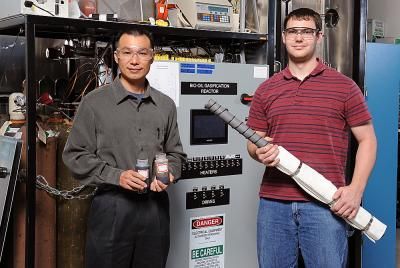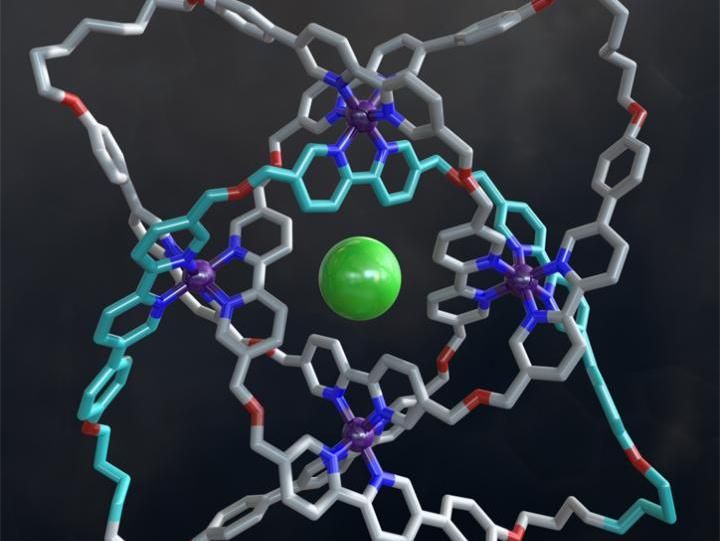Breaking the ties that bind: New hope for biomass fuels
Los Alamos researchers crack code for binding lignocellulosic biomass
Los Alamos National Laboratory researchers have discovered a potential chink in the armor of fibers that make the cell walls of certain inedible plant materials so tough. The insight ultimately could lead to a cost-effective and energy-efficient strategy for turning biomass into alternative fuels.
In separate papers published in Biophysical Journal and recently in an issue of Biomacromolecules, Los Alamos researchers identify potential weaknesses among sheets of cellulose molecules comprising lignocellulosic biomass, the inedible fibrous material derived from plant cell walls. The material is a potentially abundant source of sugar that can be used to brew batches of methanol or butanol, which show potential as biofuels.
Cellulose is biosynthesized in plant cells when molecules of glucose - a simple sugar - join into long chains through a process called polymerization. The plant then assembles these chains of cellulose into sheets. The sheets are held together by hydrogen bonds - an electrostatic attraction of a positive portion of a molecule to a negative portion of the same or neighboring molecule. Finally, the sheets stack atop one another, sticking to themselves by other types of attractions that are weaker than hydrogen bonds. The plant then spins these sheets into high-tensile-strength fibers of material.
Not only are the fibers incredibly strong, but they are incredibly resistant to the action of enzymes called cellulases that can crack the fibers back into their simple-sugar components. The ability to economically and easily break cellulose into sugars is desirable because the sugars can be used to create fuel alternatives. However, due to the tenacity of cellulose fibers, the United States currently lacks an energy-efficient and cost-effective method for turning inedible biomass such as switch grass or corn husks into a sweet source of biofuels.
Working with researchers from the U.S. Department of Agriculture and the Centre de Recherches sur les Macromolécules Végétales in France, Los Alamos researcher Paul Langan used neutrons to probe the crystalline structure of highly crystalline cellulose, much like an X-ray is used to probe the hidden structures of the body. Langan and his colleagues found that although cellulose generally has a well-ordered network of hydrogen bonds holding it together, the material also displays significant amounts of disorder, creating a different type of hydrogen bond network at certain surfaces. These differences make the molecule potentially vulnerable to an attack by cellulase enzymes.
Moreover, in Biophysical Journal, Los Alamos researchers Tongye Shen and Gnana Gnanakaran describe a new lattice-based model of crystalline cellulose. The model predicts how hydrogen bonds in cellulose can shift to remain stable under a wide range of temperatures. This plasticity allows the material to swap different types of hydrogen bonds but also constrains the molecules so that they must form bonds in the weaker configuration described by Langan and his colleagues. Most important, Shen and Gnanakaran's model identifies hydrogen bonds that can be manipulated via temperature differences to potentially make the material more susceptible to attack by enzymes that can crack the fibers into sugars for biofuel production.
"We have been able to identify a chink in the armor of a very tough and worthy adversary - the cellulose fiber," said Gnanakaran, who leads the theoretical portion of a large, multidisciplinary biofuels project at Los Alamos.
"These results are some of the first to come from this team, and eventually could point us toward an economical and viable process for making biofuels from cellulosic biomass," adds Langan, director of the biofuels project.
Most read news
Topics
Organizations
Other news from the department science
These products might interest you

Berghof - Reactor Controller by Berghof
High-performance heating system: Precision for small reactors up to 300 ml
Discover auto-tuning, intelligent stirring and air cooling for precise process control

Berghof Reaktortechnologie - Hoch- und Niederdruckreaktoren, Druckbehälter und metallfreie Reaktoren by Berghof
Safe high- and low-pressure systems for aggressive media
Corrosion-resistant reactors with PTFE lining - individually configurable

Get the chemical industry in your inbox
By submitting this form you agree that LUMITOS AG will send you the newsletter(s) selected above by email. Your data will not be passed on to third parties. Your data will be stored and processed in accordance with our data protection regulations. LUMITOS may contact you by email for the purpose of advertising or market and opinion surveys. You can revoke your consent at any time without giving reasons to LUMITOS AG, Ernst-Augustin-Str. 2, 12489 Berlin, Germany or by e-mail at revoke@lumitos.com with effect for the future. In addition, each email contains a link to unsubscribe from the corresponding newsletter.



























































